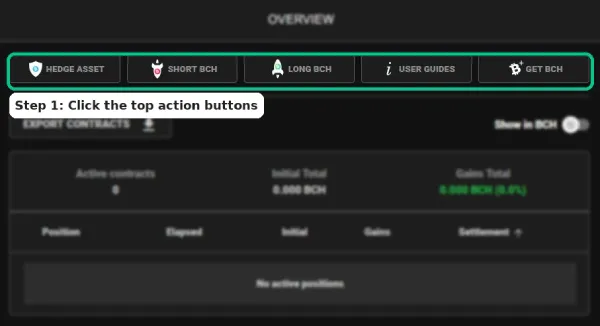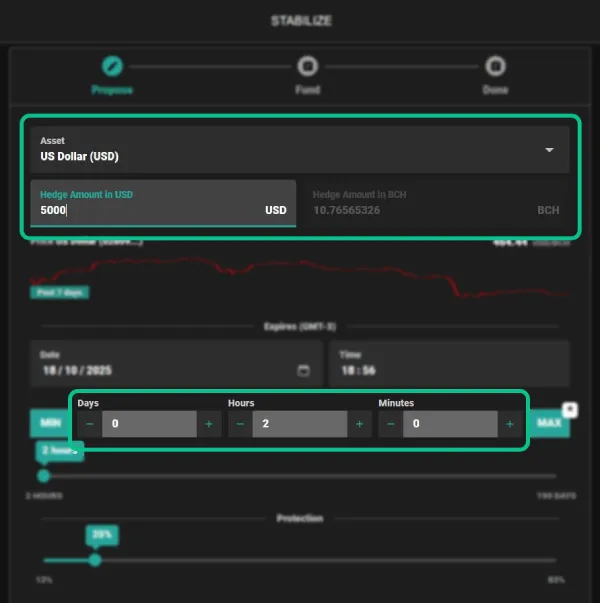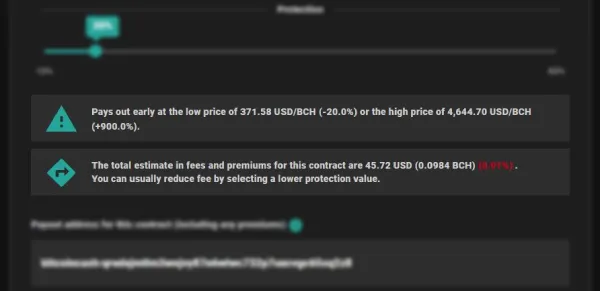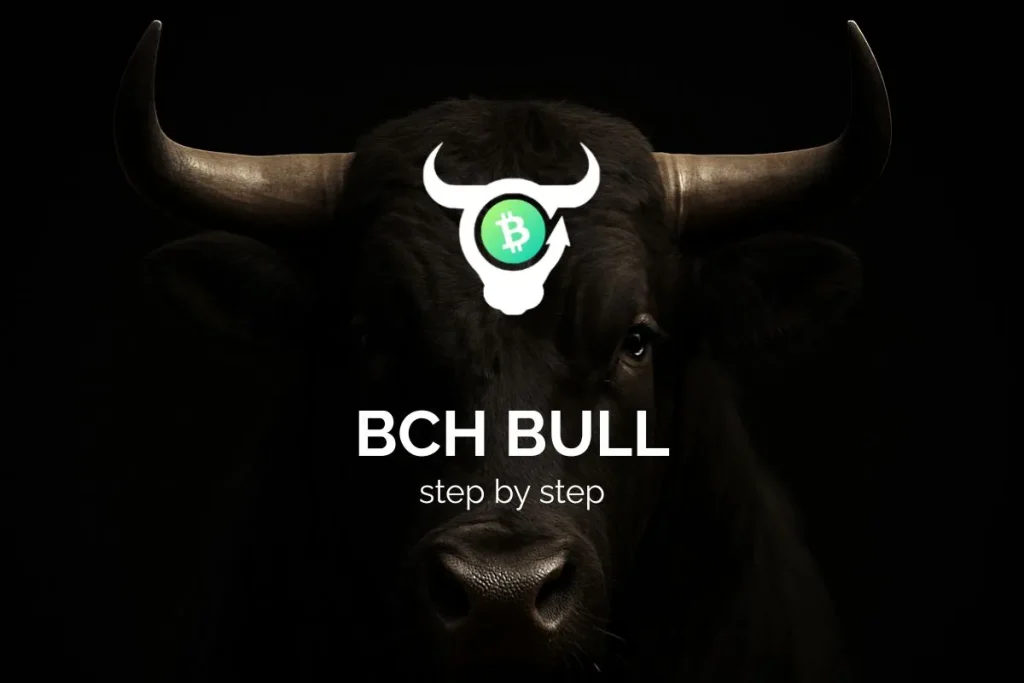BCH Bull is an app for DeFi trading from your wallet via smart contracts. Select an asset, set the contract parameters and lock the exact BCH amount in the contract. Rules are hard-coded in the blockchain — transparent and non‑custodial.
What you can do — Types of contracts
Available assets are Gold, Silver, USD, ETH, BTC, EUR, INR, CNY, PHP.
Contracts have a defined duration and maturity (not perpetual): from 2 hours to 6 months.
Hedge BCH against an asset
Locking the value of BCH against a reference asset behaves like “investing in asset”: at settlement, the payout is BCH whose value equals the units of the chosen asset fixed at contract creation (e.g., hedging vs Gold pays BCH equal to the initial ounces; hedging vs USD locks the USD value).
Long or Short BCH against an asset
Directional exposure to the price of BCH relative to a reference asset, with leverage (up to 7.77x). Liquidation and early‑payout thresholds are previewed (chosen) before proposing.
How BCH Bull works
A non‑custodial web app that creates on‑chain smart contracts among two parties using the AnyHedge protocol: one goes long and the other goes short against an oracle price. A liquidity provider (LP) takes the other side of your bet quoting a premium (sometimes negative) based on market conditions.
Contracts use cryptographically signed, publicly verifiable oracles. BCH Bull uses General Protocols’ oracles, with a 3+ year track record and 130k+ transactions.
Funds are in "programmed vaults" — there's no custodial intermediary and the smart contracts have been audited. That said, consider the following risks:
- Prices can move against the position; gains and losses are possible.
- Leveraged positions can be closed by liquidation or early payout if thresholds are crossed.
- Oracle dependency: contracts rely on cryptographically signed, publicly verifiable price feeds. More below.
Provider: BCH Bull uses General Protocols’ oracles, with a 3+ year track record and 130k+ transactions.
- What they sign: the current reference price for the selected market (e.g., USD, EUR, XAU/Gold, BTC, ETH).
- How it’s used: signatures are verified by the protocol; the contract applies the signed price for enforcement and settlement on‑chain.
- Update cadence: typically around every 15 seconds (approximate, not guaranteed).
See Oracles.Cash for the technicals.
On first use, the app may prompt to create or back up a browser key/seed. This key lets the interface identify your session and monitor contracts across devices when imported. Funds do not pass through this key; payouts always go to the payout address set for each contract. You can back it up later without affecting contract execution.
Contract examples
(Illustrative. Ignores premiums and assumes thresholds are not breached.)
Hedge vs Gold (30 days)
Start values (t₀):
BCH price: $530 per BCH
Gold price: $4,000 per oz
Collateral: 1 BCH
What the hedge locks:
Contract in gold units = $530 / $4,000 = 0.1325 oz. (worth $530 USD)
End values at maturity (t₁):
BCH price: $567.10 (+7%)
Gold price: $4,120 (+3%)
Payout in BCH at maturity:
Locked ounces × Goldₜ₁ / BCHₜ₁ = 0.9626 BCH (worth $545.90).
Gold rose +3% while BCH rose +7%; on maturity, the hedge side receives ~0.9626 BCH (worth $545.90 ≈ +3% vs the initial $530).
Bottom line: A hedge vs Gold is effectively a synthetic gold investment: if gold rises 3% over the term, the contract’s fiat value rises 3% (assumes no threshold events).
Long BCH vs ETH (2× leverage)
Start values (t₀):
BCH price: $540
ETH price: $4,000
Leverage: 2×
Collateral: 1 BCH
Scenario 1 — BCH outperforms ETH
End values (t₁): BCH $604.8 (+12%); ETH $4,080 (+2%).
BCH/ETH ratio change: +9.80%.
P&L at 2×: ≈ +19.61% → ~1.196 BCH received.
Scenario 2 — ETH outperforms BCH (no threshold breach)
End values (t₁): BCH $518.4 (-4%); ETH $4,160 (+4%).
BCH/ETH ratio change: −7.62%.
P&L at 2×: ≈ −15.24% → ~0.848 BCH
received.
Note: Actual liquidation/early‑payout lines are displayed before proposing; these example scenarios are sized to avoid hitting thresholds.
How to enter a contract on BCH Bull — Step by Step
Step 0 - First‑time setup: set the payout address
Step 1 - Choose mode (hedge/long/short)

Use the main menu buttons (Hedge/Short/Long BCH). This selects how the position behaves. Asset selection and all other settings come next.
Step 2 - Set asset & contract parameters

Select the asset, then define the contract value (in BCH or asset terms) and the duration. Set:
Parameters — quick reference
Step 3 - Review the offer and propose

Check the summary: market, size, maturity, both liquidation/early‑payout thresholds, and the LP premium (green = you receive; red = you pay). If acceptable, click Propose.
Step 4 - Fund exactly, within the time window

Scan the funding QR / copy the address and send the exact BCH amount from your wallet. If a mismatch/timeout occurs, funds are automatically returned to your payout address with an error note. When funded, the contract is live.
Practical use cases
Use case 1 - Lock part of a pump (partial USD hedge)
Context: Alex holds about $50,000 in BCH. Upon waking up and seeing a +20% jump, with his BCH now worth about $60,000, Alex hedges $10,000 in USD for 30 days to secure part of the gains.
Setup: Hedge mode, USD, asset amount $10,000, maturity 30d.
Outcome: At maturity, Alex receives $10,000 worth of BCH.
Bottom line: A USD hedge is on‑chain fiat value without stablecoins.
Use case 2 - Gold exposure without brokers or banks
Context: Amina wants $5,000 exposure to Gold for 60 days without bank intermediaries or centralized tokens. She swaps to BCH and opens a hedge vs Gold.
Setup: Hedge mode, Gold, $5,000 worth of BCH, maturity 60d.
Outline: At maturity, Amina receives BCH equal to the initial ounces fixed at creation (synthetic gold exposure on‑chain).
Bottom line: A Gold hedge is a decentralized gold investment on the Bitcoin Cash network.
Frequently Asked Questions
No. Funds are locked in BCH smart contracts under the AnyHedge protocol (on-chain).
Available assets are Gold, Silver, Ethereum (ETH), Bitcoin (BTC), USD, EUR, INR, CNY, and PHP.
The premium is the LP’s price to take the other side of your contract. In the UI, red = you pay; green = you receive (green premiums are paid to your payout address when funding succeeds). Premiums reflect market conditions and your parameters (asset, maturity, Protection/Leverage, Counterparty leverage).
The current premiums can be seen in the BCH Bull premiums page.
On Bitcoin Cash, on‑chain network fees are typically < $0.01 per transaction. Creating/funding a BCH Bull contract and receiving the payout are standard BCH transactions, so total network cost usually stays under a cent.
No. Once funded, parameters are fixed for the term. To alter exposure, settle (or wait for maturity) and open a new contract with updated parameters.
Early Settlement is available only if enabled at contract creation and only when more than 2 hours remain in the term. The ES premium is quoted by the LP and shown in the contract summary.
All payouts and any returned funds (e.g., failed funding) are sent to the payout address set for that specific contract.
Common causes are: the funding amount didn’t match the exact total shown in the contract summary; the time window expired; or a duplicate/late payment was detected. In these cases, funds are automatically returned to the contract’s payout address with an error note. To succeed next time, fund the exact BCH amount within the displayed window.
This isn’t a smart-contract failure; it’s a creation condition not met. Funds either create the contract (when conditions match) or return to your payout address.

